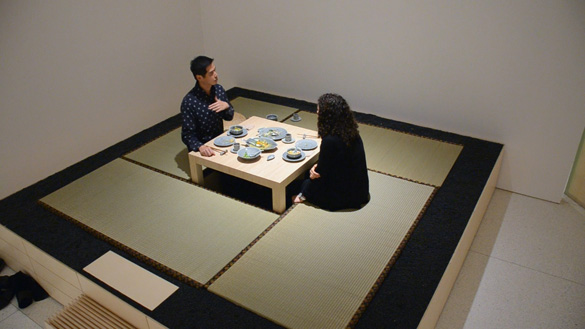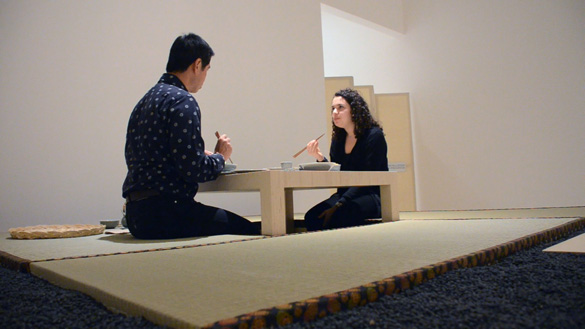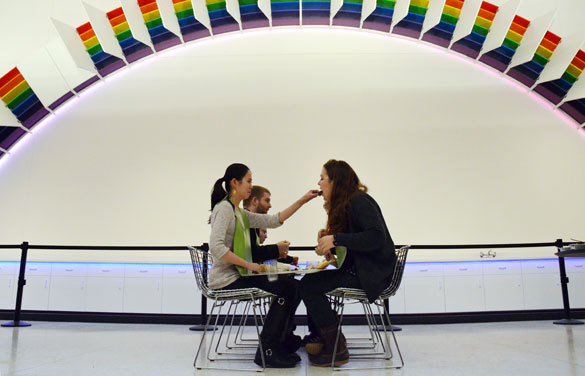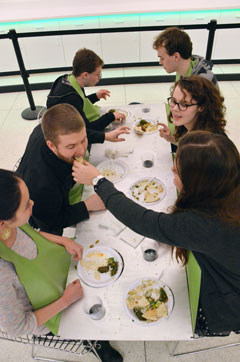Join the Feast: February 2012 Archives

By Dory Fox
University of Chicago third-year undergraduate, double major in English and Jewish Studies
Smart Museum Café attendant
The performative nature of Lee Mingwei's The Dining Project rang a particularly strong chord for me as an employee of the Smart Museum, whose usual role is to welcome the museum's guests and to provide them with food. I spend hours each week serving guests in the Museum's café, while Mingwei was a visiting artist, creating a new project for the museum's exhibition. And yet, he welcomed me; he made me feel like a hosted guest. This role reversal called my attention to the way that our physical surroundings affect our social roles. However, through the establishment that Mingwei would be the host and I the guest, I also saw how deciding to take a new role can transform how we interact with our surroundings, and can de-familiarize a once familiar space.
One of my favorite parts of Mingwei's piece was the physical design of the table and seating area. When a person sits at a table in a restaurant, or in another person's home, they are exposed. A table acts to shield a person's body to an extent, but a seated individual, stagnant, casted to the shape of his chair, becomes an object on display, just like any other piece in a dining room or in a gallery.

However, I believe that Mingwei's design combated this feeling of display and exposure that one can feel while dining in an unfamiliar environment. I was very surprised when I approached the table, and Mingwei swung his legs around let them hang into a square recess beneath the table. Rather than sitting on chairs or on the ground, we were sitting on closed square of benches. The dining set was like a building, and our legs rested in its courtyard. The platform he had built transformed in my mind from a pedestal to a fortress, from a structure of display to one of protection. This scheme made me feel safe comfortable from the moment I sat down.
Mingwei had also filled the "courtyard" with black beans, which provided a massage for our socked feet when we sat at the table. I spent nearly the entire meal tracing circles in the beans with my feet, like a child playing in the sand at the beach. I thought the beans were a lighthearted and fanciful touch, which provided a constant sensory experience throughout the course of the meal. We are so used to the idea of hospitality through our sense of taste, but people rarely think of how hosts attend to the other senses of their guests. The black bean foot massage heightened my awareness of the importance of sensory comfort and pleasure in hospitality encounters. The significance of sharing a meal lies not only in sharing physical nourishment but also in sharing physical pleasure. I think that this allows for certain level of human recognition: your host or your guest, like you, has a human body that needs sustenance, and your host or guest, like you, has a human body that experiences pleasure.
Join the Feast: the artist will be back in Chicago to host three more one-on-one dinners in the Smart's galleries on April 30, May 1, and May 2. Guests will be chosen by lottery. To enter the drawing or to learn more about this and other participatory projects, visit smartmuseum.uchicago.edu/join-the-feast.
Above: Dory Fox and Lee Mingwei dining at the Smart. Photos by Steve Rosofsky.
The performative nature of Lee Mingwei's The Dining Project rang a particularly strong chord for me as an employee of the Smart Museum, whose usual role is to welcome the museum's guests and to provide them with food. I spend hours each week serving guests in the Museum's café, while Mingwei was a visiting artist, creating a new project for the museum's exhibition. And yet, he welcomed me; he made me feel like a hosted guest. This role reversal called my attention to the way that our physical surroundings affect our social roles. However, through the establishment that Mingwei would be the host and I the guest, I also saw how deciding to take a new role can transform how we interact with our surroundings, and can de-familiarize a once familiar space.
One of my favorite parts of Mingwei's piece was the physical design of the table and seating area. When a person sits at a table in a restaurant, or in another person's home, they are exposed. A table acts to shield a person's body to an extent, but a seated individual, stagnant, casted to the shape of his chair, becomes an object on display, just like any other piece in a dining room or in a gallery.

However, I believe that Mingwei's design combated this feeling of display and exposure that one can feel while dining in an unfamiliar environment. I was very surprised when I approached the table, and Mingwei swung his legs around let them hang into a square recess beneath the table. Rather than sitting on chairs or on the ground, we were sitting on closed square of benches. The dining set was like a building, and our legs rested in its courtyard. The platform he had built transformed in my mind from a pedestal to a fortress, from a structure of display to one of protection. This scheme made me feel safe comfortable from the moment I sat down.
Mingwei had also filled the "courtyard" with black beans, which provided a massage for our socked feet when we sat at the table. I spent nearly the entire meal tracing circles in the beans with my feet, like a child playing in the sand at the beach. I thought the beans were a lighthearted and fanciful touch, which provided a constant sensory experience throughout the course of the meal. We are so used to the idea of hospitality through our sense of taste, but people rarely think of how hosts attend to the other senses of their guests. The black bean foot massage heightened my awareness of the importance of sensory comfort and pleasure in hospitality encounters. The significance of sharing a meal lies not only in sharing physical nourishment but also in sharing physical pleasure. I think that this allows for certain level of human recognition: your host or your guest, like you, has a human body that needs sustenance, and your host or guest, like you, has a human body that experiences pleasure.
Join the Feast: the artist will be back in Chicago to host three more one-on-one dinners in the Smart's galleries on April 30, May 1, and May 2. Guests will be chosen by lottery. To enter the drawing or to learn more about this and other participatory projects, visit smartmuseum.uchicago.edu/join-the-feast.
Above: Dory Fox and Lee Mingwei dining at the Smart. Photos by Steve Rosofsky.
 Two weeks ago six University of Chicago students shared a memorable dinner around Mella Jaarsma's participatory sculpture in the Smart Museum lobby. Jaarsma's piece, I Eat You Eat Me, is a wearable table: a lightweight metal surface held between six leather yokes that sit over diner's chests like bibs. Jaarsma designed this six-person version for Feast based on a two-person model she has used in open-ended participatory performances in Yogyakarta since 2002. In preparation for the opening of Feast, the students were invited to don the yokes and, balancing the table surface on their knees, were invited to feed each other. Art history student and Smart Museum Student Advisory Committee member James Levinsohn reflects on the experience:
Two weeks ago six University of Chicago students shared a memorable dinner around Mella Jaarsma's participatory sculpture in the Smart Museum lobby. Jaarsma's piece, I Eat You Eat Me, is a wearable table: a lightweight metal surface held between six leather yokes that sit over diner's chests like bibs. Jaarsma designed this six-person version for Feast based on a two-person model she has used in open-ended participatory performances in Yogyakarta since 2002. In preparation for the opening of Feast, the students were invited to don the yokes and, balancing the table surface on their knees, were invited to feed each other. Art history student and Smart Museum Student Advisory Committee member James Levinsohn reflects on the experience:In enacting Mella Jaarsma's piece, I experienced feeding another person and being fed by another person for the first time in my adult life. The experience engendered all sorts of associations, variously centered on species, religious ceremony, age and ability, and politics.
However, through all the associations, one constant remained -- the way the ritual of feeding and being fed articulates power relations. Nourishment is a basic requirement of human life, and being nourished by someone else, however briefly, figuratively places the power of sustaining their life in your hands. Conversely, being fed by someone else gives them the power of sustaining your life. By being in both positions over the course of the performance, I experienced both extraordinary power and extraordinary powerlessness.
 I was both the priest giving communion and the parishioner receiving the body and blood of Christ; I was both the pet owner feeding their parakeet and the parakeet; I was both the baby or the invalid being generously fed by their caretaker, and that caretaker; and I was both the Roman Emperor being fed grapes, and the subjugated slave feeding them grapes.
I was both the priest giving communion and the parishioner receiving the body and blood of Christ; I was both the pet owner feeding their parakeet and the parakeet; I was both the baby or the invalid being generously fed by their caretaker, and that caretaker; and I was both the Roman Emperor being fed grapes, and the subjugated slave feeding them grapes. Through filling both these roles in the course of one performance, power relations emerge as contingent. Mella Jaarsma's piece reinforced my belief that the roles we play in power relations are not innate, but change based on circumstance, and that everyone is simultaneously empowered and deprived of power in different spheres of life. In Mella Jaarsma's piece, our proximity to those we have power towards makes us generous; one wishes this was the case more often outside of art.
Video documentation of the students' dinner will be on view in the gallery, along with the six-person version of the table, and video documentation from a parallel I Eat You Eat Me performance Jaarsma organized in Yogyakarta to coincide with the opening of Feast. Throughout the duration of Feast, a two-person version of the piece will be available to all museum guests to try out at the Smart Cafe.
Images: Students share a dinner with Mella Jaarsma's I Eat You Eat Me wearable table. Photos by Steve Rosofsky, 2012.
"Is this art? Could this be art?"
Lee Mingwei discusses the history of The Dining Project, a participatory artwork where he and a guest dine in the museum after hours within an elegant installation. Lee will be hosting a handful of dinners at the Smart, with guests chosen by lottery.